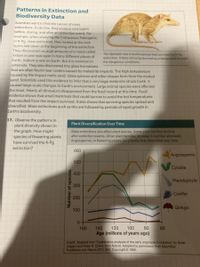
Human Anatomy & Physiology (11th Edition)
11th Edition
ISBN: 9780134580999
Author: Elaine N. Marieb, Katja N. Hoehn
Publisher: PEARSON
expand_more
expand_more
format_list_bulleted
Question
Please answer this ASAP number 17

Transcribed Image Text:Patterns in Extinction and
Biodiversity Data
Scientists want to find the causes of mass
extinctions. To do this, they analyze rock layers
before, during, and after an extinction event. For
example, when studying the Cretaceous-Paleogene,
or K-Pg, mass extinction, they looked at the rock
layers laid down at the beginning of this extinction.
They discovered unusual amounts of a metal called
iridium in one rock layer in many different places of
Earth. Iridium is rare on Earth. But it is common in
The Alphadon was a small mammal that survived the K-Pg
extinction. It likely did so by burrowing underground to avoid
the dangerous conditions.
asteroids. They also discovered tiny glass formations
that are often found near craters caused by meteorite impacts. The high temperature
caused by the impact melts sand. Glass spheres and other shapes form from the melted
sand. Scientists used this evidence to infer that a very large meteorite struck Earth. It
caused large-scale changes to Earth's environment. Large animal species were affected
the most. Nearly all dinosaurs disappeared from the fossil record at this time. Fossil
evidence shows that small mammals that could burrow to avoid the hot temperatures
that resulted from the impact survived. It also shows that surviving species spread and
diversified. Mass extinctions such as this are followed by periods of rapid growth in
Earth's biodiversity.
17. Observe the patterns in
Plant Diversification Over Time
plant diversity shown in
the graph. How might|
species of flowering plants
have survived the K-Pg
Mass extinctions also affect plant species. Some plant families decline
after extinction events. Other plant families increase in number afterward.
Angiosperms, or flowering plants, are a family that diversified over time.
extinction?
600
Angiosperms
500
Cycads
400
Pteridophyte
300
Conifer
200
Ginkgo
100
120
100
Age (millions of years ago)
160
140
80
60
Credit: Adapted from "Quantitative analyses of the early angiosperm radiation" by Scott
Lidgard and Peter R. Crane, from Nature. Adapted by permission from Macmillan
Publishers Ltd: Nature (331), 344. Copyright 1988.
Number of species
Expert Solution
This question has been solved!
Explore an expertly crafted, step-by-step solution for a thorough understanding of key concepts.
This is a popular solution
Trending nowThis is a popular solution!
Step by stepSolved in 2 steps

Knowledge Booster
Learn more about
Need a deep-dive on the concept behind this application? Look no further. Learn more about this topic, biology and related others by exploring similar questions and additional content below.Similar questions
- Post a short summary about the assigned video posted below https://www.youtube.com/watch?v=5-bN7qB_kckarrow_forwardi can't read that hand writing you suckarrow_forwardHello, I am working in an assignment about San Diego but firts I need to describe the community including demographics, literacy levels, etc. Can you please help me with this? Thank you in advance!arrow_forward
arrow_back_ios
arrow_forward_ios
Recommended textbooks for you
 Human Anatomy & Physiology (11th Edition)BiologyISBN:9780134580999Author:Elaine N. Marieb, Katja N. HoehnPublisher:PEARSON
Human Anatomy & Physiology (11th Edition)BiologyISBN:9780134580999Author:Elaine N. Marieb, Katja N. HoehnPublisher:PEARSON Biology 2eBiologyISBN:9781947172517Author:Matthew Douglas, Jung Choi, Mary Ann ClarkPublisher:OpenStax
Biology 2eBiologyISBN:9781947172517Author:Matthew Douglas, Jung Choi, Mary Ann ClarkPublisher:OpenStax Anatomy & PhysiologyBiologyISBN:9781259398629Author:McKinley, Michael P., O'loughlin, Valerie Dean, Bidle, Theresa StouterPublisher:Mcgraw Hill Education,
Anatomy & PhysiologyBiologyISBN:9781259398629Author:McKinley, Michael P., O'loughlin, Valerie Dean, Bidle, Theresa StouterPublisher:Mcgraw Hill Education, Molecular Biology of the Cell (Sixth Edition)BiologyISBN:9780815344322Author:Bruce Alberts, Alexander D. Johnson, Julian Lewis, David Morgan, Martin Raff, Keith Roberts, Peter WalterPublisher:W. W. Norton & Company
Molecular Biology of the Cell (Sixth Edition)BiologyISBN:9780815344322Author:Bruce Alberts, Alexander D. Johnson, Julian Lewis, David Morgan, Martin Raff, Keith Roberts, Peter WalterPublisher:W. W. Norton & Company Laboratory Manual For Human Anatomy & PhysiologyBiologyISBN:9781260159363Author:Martin, Terry R., Prentice-craver, CynthiaPublisher:McGraw-Hill Publishing Co.
Laboratory Manual For Human Anatomy & PhysiologyBiologyISBN:9781260159363Author:Martin, Terry R., Prentice-craver, CynthiaPublisher:McGraw-Hill Publishing Co. Inquiry Into Life (16th Edition)BiologyISBN:9781260231700Author:Sylvia S. Mader, Michael WindelspechtPublisher:McGraw Hill Education
Inquiry Into Life (16th Edition)BiologyISBN:9781260231700Author:Sylvia S. Mader, Michael WindelspechtPublisher:McGraw Hill Education

Human Anatomy & Physiology (11th Edition)
Biology
ISBN:9780134580999
Author:Elaine N. Marieb, Katja N. Hoehn
Publisher:PEARSON

Biology 2e
Biology
ISBN:9781947172517
Author:Matthew Douglas, Jung Choi, Mary Ann Clark
Publisher:OpenStax

Anatomy & Physiology
Biology
ISBN:9781259398629
Author:McKinley, Michael P., O'loughlin, Valerie Dean, Bidle, Theresa Stouter
Publisher:Mcgraw Hill Education,

Molecular Biology of the Cell (Sixth Edition)
Biology
ISBN:9780815344322
Author:Bruce Alberts, Alexander D. Johnson, Julian Lewis, David Morgan, Martin Raff, Keith Roberts, Peter Walter
Publisher:W. W. Norton & Company

Laboratory Manual For Human Anatomy & Physiology
Biology
ISBN:9781260159363
Author:Martin, Terry R., Prentice-craver, Cynthia
Publisher:McGraw-Hill Publishing Co.

Inquiry Into Life (16th Edition)
Biology
ISBN:9781260231700
Author:Sylvia S. Mader, Michael Windelspecht
Publisher:McGraw Hill Education